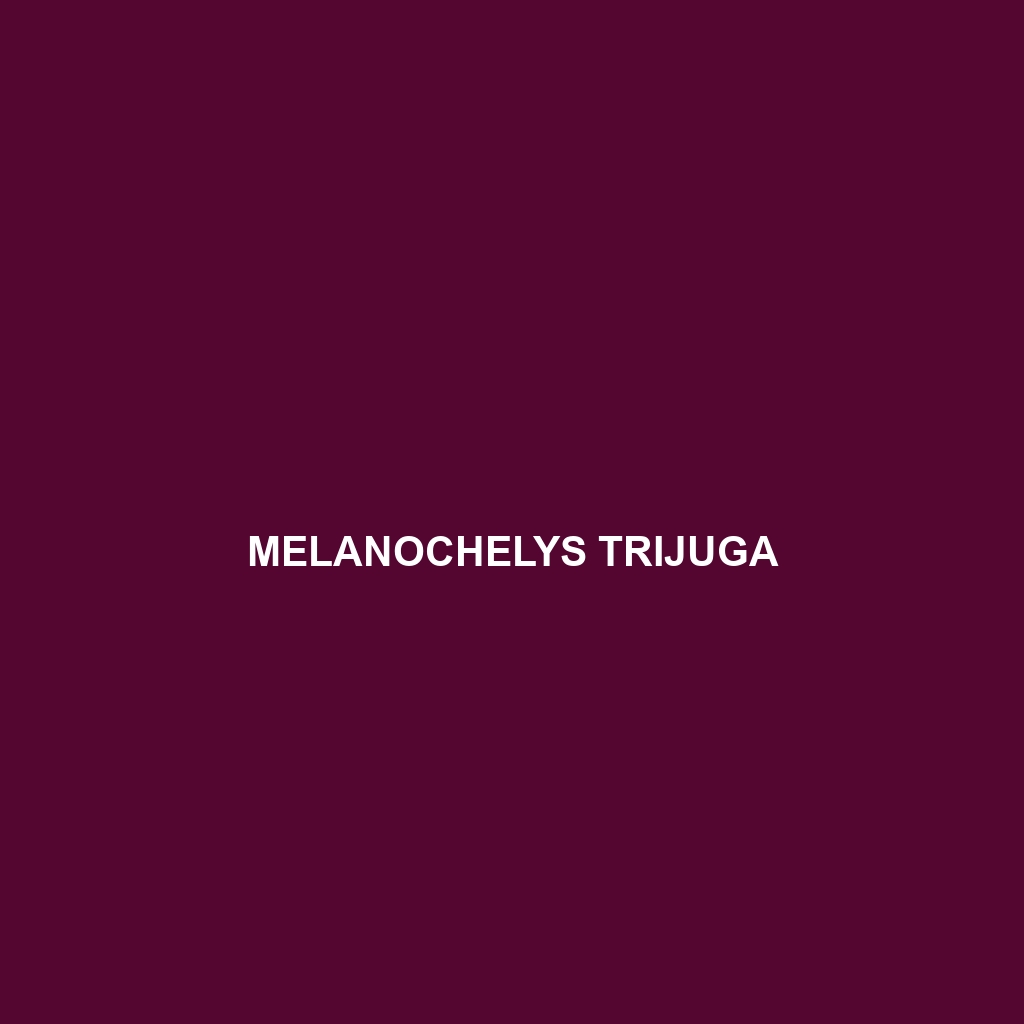Common Name
Melanochelys trijuga
Scientific Name
Melanochelys trijuga
Habitat
Melanochelys trijuga, commonly known as the Indian black turtle, is primarily found in several geographic regions of India and Southeast Asia. This semi-aquatic species thrives in a range of habitats, including freshwater lakes, ponds, rivers, and wetlands. The turtles prefer environments with abundant vegetation and clean, slow-moving waters. In addition to freshwater habitats, they can also be found in brackish waters and marshy areas, showcasing their adaptability to various climate conditions. These turtles are especially common in tropical and subtropical regions, where temperatures are warm, which promotes their activity levels. Rainforests and temperate forests adjacent to these water bodies provide essential cover and food sources, making them crucial components of the ecosystem.
Physical Characteristics
Melanochelys trijuga has distinctive physical characteristics that set it apart from other turtle species. Adults typically reach a shell length of about 20 to 30 centimeters (8 to 12 inches). The carapace is dark brown to black, often exhibiting a slight sheen that helps them camouflage against the muddy riverbeds and aquatic vegetation. The shell is slightly domed with a smooth surface and features serrated edges, which is characteristic of this species. The plastron (the underside of the shell) is usually yellowish or light tan, providing contrast against the darker carapace. Their limbs are strong and are equipped with webbed feet, facilitating swift movement both in water and on land. Additionally, the turtles possess a small head with a pointed snout and large, expressive eyes, which enhance their capabilities in both terrestrial and aquatic environments.
Behavior
Typical behaviors observed in Melanochelys trijuga include a mix of both aquatic and terrestrial activities. These turtles are known to bask in the sun on rocks or logs, which helps regulate their body temperature. They exhibit mostly diurnal behavior, being active during daylight hours. Nesting usually occurs in the rainy season, where females migrate to traditional nesting sites. During this mating season, males perform elaborate courtship displays, which involve swimming around females and nuzzling their shells. Additionally, Melanochelys trijuga exhibits social interactions when basking; they can often be seen resting closely together. Their unique habit of diving to the substrate when startled demonstrates their excellent swimming skills and ability to evade predators.
Diet
Melanochelys trijuga is primarily an omnivore, showcasing a varied diet. They consume a range of food items, including aquatic plants, algae, fruits, small invertebrates, and occasionally even fish. Their preference for plant matter aligns with the lush vegetation in their habitats, where they can graze on various aquatic and terrestrial plants. This dietary flexibility aids in their survival, particularly in the fluctuating environmental conditions of their diverse habitats. The turtles play a significant role in maintaining the health of their ecosystems by controlling plant growth and providing a food source for predators.
Reproduction
The reproductive cycle of Melanochelys trijuga follows a seasonal pattern, typically occurring during the monsoon months when environmental conditions are ideal. Mating rituals are elaborate, with males displaying various behaviors to attract females. After mating, females lay anywhere from 5 to 12 eggs in sandy nests dug on the riverbanks. The incubation period ranges from 60 to 90 days, depending on environmental conditions, primarily temperature and humidity. Once the eggs hatch, the young turtles are immediately independent and must fend for themselves, demonstrating a minimal level of parental care post-hatching. This independence contributes to the survival strategies of the species as offspring quickly adapt to their surroundings.
Conservation Status
The conservation status of Melanochelys trijuga is currently classified as ‘Vulnerable’ by the International Union for Conservation of Nature (IUCN). Threats to their populations include habitat destruction due to urbanization, pollution, and invasive species. Additionally, they face pressures from illegal poaching and the pet trade. Conservation efforts are underway in several regions, focusing on habitat protection, breeding programs, and raising awareness about the importance of this species in the ecosystem. Local communities are increasingly engaged in conservation initiatives, helping to mitigate threats and preserve the habitats vital for the survival of this turtle species.
Interesting Facts
One fascinating aspect of Melanochelys trijuga is their unique ability to absorb oxygen through their cloacal bursae, allowing them to remain submerged for extended periods, sometimes up to several hours. This adaptation aids in their survival during dry seasons or in polluted waters where the oxygen levels are lower. Another interesting fact is that they are sometimes referred to as ‘batagur’ in local languages, further emphasizing their cultural significance in regions where they are found. Their role as indicators of environmental health also highlights their importance in ecosystem monitoring.
Role in Ecosystem
Melanochelys trijuga plays a vital role in maintaining ecological balance within their habitats. As herbivores, they help control aquatic vegetation, preventing overgrowth and promoting biodiversity within freshwater ecosystems. Furthermore, their feeding habits contribute to nutrient cycling, benefiting both aquatic and terrestrial systems. They also serve as prey for various predators, including birds and larger fish, showcasing their importance in the food web. By supporting these interactions, Melanochelys trijuga contributes significantly to the overall health and stability of the ecosystems in which they reside.
